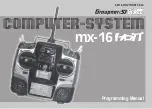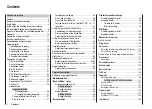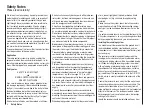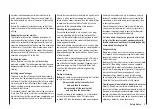
8
Safety Notes
Safety notes and handling instructions relating to Nickel-Metal-Hydride rechargeable
batteries
As with all sophisticated technical products, it is vitally
important that you observe the following safety notes
and handling instructions if you wish the equipment to
operate safely and reliably for an extended period.
Safety notes
Individual cells and rechargeable batteries are not
•
playthings, and must be kept well away from children.
Store rechargeable cells and batteries out of the
reach of children.
Check that the batteries are in perfect, serviceable
•
condition before every use. Do not re-use defective or
damaged cells or batteries.
Rechargeable cells and batteries must be used
•
within the specified limits stated for the correspond-
ing cell type.
Do not heat, incinerate or short-circuit rechargea-
•
ble cells or batteries, and never charge them with
excessive currents or reversed polarity.
Never use rechargeable batteries consisting of
•
parallel-wired cells, combinations of old and new
cells, cells of different construction, size, capaci-
ty, make, brand or cell type.
Batteries installed inside equipment should always be
•
removed from the device when it is not in use and not
about to be used. Always keep equipment switched
off in order to avoid deep-discharged cells. Batteries
must be recharged in good time.
The battery to be charged should be placed on a
•
non-inflammable, heat-resistant, non-conductive
surface for the whole of the charge period. Keep
inflammable and volatile objects and materials well
clear of the charging area.
Batteries must always be supervised when on
•
charge. Never exceed the maximum fast-charge cur-
rent specified for the cell type in use.
If the battery heats up to more than 60°C whilst on
•
charge, halt the charge process immediately and
allow the pack to cool down to about 30°C.
Never recharge a battery which is already charged,
•
hot, or not completely discharged.
Do not make any modifications to batteries. Never
•
solder or weld directly to cells.
If incorrectly handled, rechargeable batteries are at
•
risk of combustion, explosion, corrosive action and
burns. Suitable extinguishing materials include fire
blankets, CO2 fire extinguishers and sand.
Escaped electrolyte is corrosive - do not allow it to
•
contact skin or eyes. In an emergency rinse the area
immediately with plenty of clean water before seeking
medical help.
The cells’ air vents must never be blocked or sealed,
•
e. g. by solder. When soldering, the iron temperature
should not exceed 220°C, and each joint should be
completed in less than twenty seconds.
To avoid cell deformation, do not exert excessive
•
mechanical pressure on battery cells.
If a battery should be accidentally overcharged, use
•
the following procedure:
Simply disconnect the battery and leave it on a non-
inflammable surface (e. g. stone floor) until it has
cooled down. Never hold the battery in your hand, as
there is a risk that cells might explode.
Always observe the recommended rates for charging
•
and discharging.
General information
The capacity of your rechargeable battery diminishes
with every charge / discharge process. Stored batteries
may eventually exhibit reduced capacity.
Storage
Batteries should not be stored in a completely dis-
charged state. Store them in a dry enclosed space at an
ambient temperature of +5°C to +25°C. If you are storing
a battery for a period longer than four weeks, ensure
that the cell voltage does
not fall below
1.2 V
Balancing individual battery cells
To balance new battery cells, i. e. to bring them all
•
to the same state of charge, charge them at what
is known as the ‘normal’ rate until they are full. As a
general guideline a fully discharged battery needs to
be charged for a period of twelve hours at a current
corresponding to one tenth of the capacity printed on
the cell label (the “1/10C” method). After this treat-
ment all the cells will be fully charged, and exhibit
the same voltage. This method of balancing battery
cells should be repeated after every ten fast-charge
processes, so that the cells are repeatedly balanced;
this helps to ensure an extended useful life for your
batteries.
If you have the facilities to discharge individual cells,
•
we recommend that you make use of this before
every charge process. Otherwise the battery pack
should be run down to a discharge voltage of 0.9
V per cell. For example, this corresponds to a final
discharge voltage of 3.6 V in the case of the four-cell
pack used in the transmitter.
Charging
NiMH batteries should only be charged using the speci-
fied currents, charge times and temperature range, and
should be supervised constantly when on charge. If you
Summary of Contents for mx-12 Hott
Page 1: ...Programming Manual 33116 mx 16 HoTT 3 en mx 16...
Page 35: ...35 For your notes...
Page 49: ...49 For your notes...
Page 55: ...55 For your notes...
Page 59: ...59 For your notes...
Page 63: ...63 For your notes...
Page 69: ...69 For your notes...
Page 91: ...91 For your notes...
Page 101: ...101 For your notes...
Page 123: ...123 For your notes...
Page 181: ...181 For your notes...
Page 193: ...193 For your notes...









































